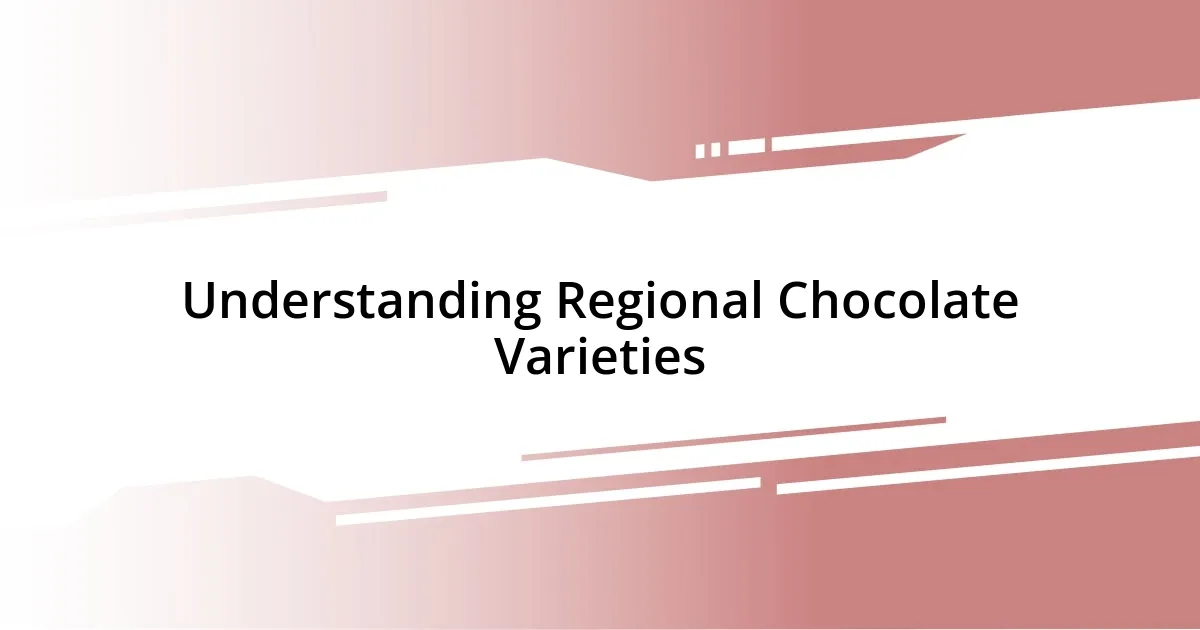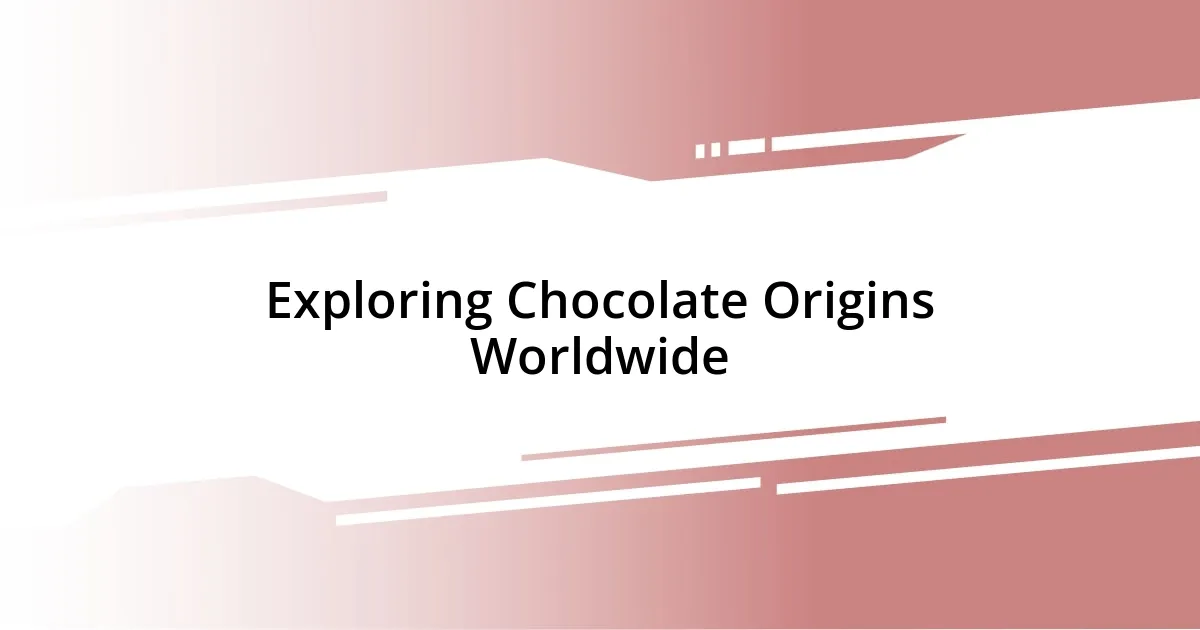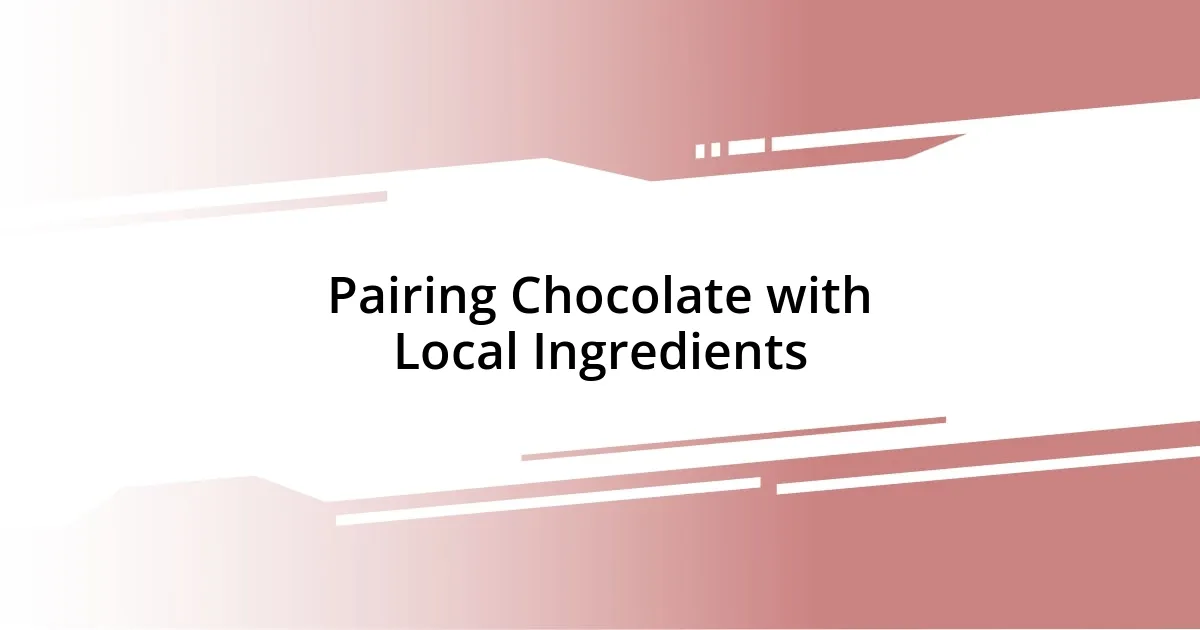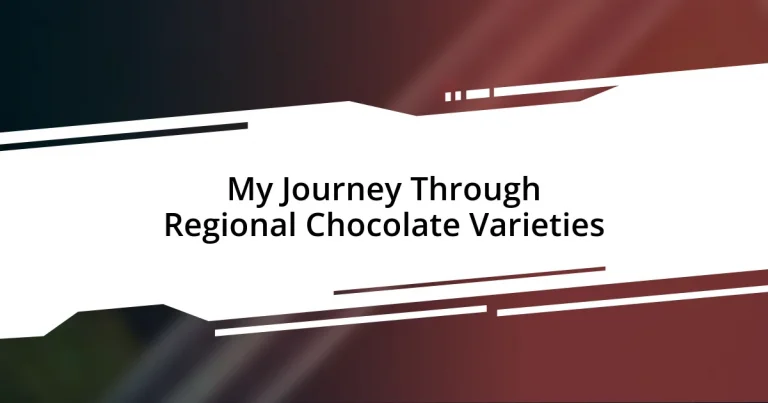Key takeaways:
- Regional chocolate varieties reflect unique terroirs and cultural influences, greatly affecting flavors and experiences.
- Chocolate production involves key steps such as harvesting, fermentation, and roasting, each critical in developing flavor profiles.
- Tasting techniques, including the “snap test,” aroma assessment, and allowing chocolate to melt, enhance appreciation and enjoyment.
- Pairing chocolate with local ingredients showcases regional flavors and enriches the overall tasting experience.

Understanding Regional Chocolate Varieties
Understanding regional chocolate varieties opens up a world of flavors that reflect the unique terroirs and cultures where the cocoa is grown. For me, tasting a chocolate from Ecuador was like taking a bite of history, as you could feel the influence of the Andes mountains and the vibrant local traditions infused into every square. Doesn’t it spark curiosity how a single ingredient can tell such diverse stories across the globe?
When I first tried the spicy notes of Mexican chocolate, it hit me right in the heart. The warmth of cinnamon and chili pepper wasn’t just a flavor; it was an experience steeped in celebration. This made me wonder, how do chocolate-making techniques vary from one region to another, affecting taste and texture? Understanding these nuances transforms the way we experience chocolate.
The subtleties of regional chocolate varieties can change your palate forever. The stark contrast between the fruity chocolate from Madagascar and the deep, earthy tones of dark chocolate from Ghana is a testament to how geography shapes flavor profiles. Every time I share these chocolates with friends, it feels like guiding them through a delightful journey. Isn’t it fascinating how each bite can ignite such cherished discussions and memories?

Exploring Chocolate Origins Worldwide
There’s something profoundly moving about exploring the diverse origins of chocolate. When I first savored a bar from Peru, the floral undertones instantly transported me to a lush rainforest, connecting me to the farmers who dedicate their lives to cultivating cacao in harmony with nature. Each piece of chocolate seems to carry a whisper of its origin, a testament to the dedication behind each cocoa bean.
- South America: Ecuador’s complex flavors reflect its rich volcanic soil.
- Central America: Mexican chocolate tells stories of ancient civilizations with its traditional spices.
- Africa: Ghana’s deep, cocoa-rich varieties showcase the importance of community in sustainable farming.
- Asia: In Indonesia, the chocolate’s more pronounced earthy notes hint at its tropical surroundings.
It’s in these unique profiles that I find not just flavor, but a sense of place, history, and belonging. Each chocolate I try brings me closer to the landscapes and cultures that create these exquisite treats.

Unique Flavors from Different Regions
When I think of the unique flavors of regional chocolates, the vivid memories start flooding in. I remember one evening in a quaint café, I tasted chocolate from Madagascar for the first time. The bright, fruity notes surprised me—they were almost reminiscent of ripe berries! It was pure joy on my palate. Madagascar’s chocolate is like a sunny day captured in a bite, and I couldn’t help but share this newfound treasure with everyone around me.
Another experience that stands out is the discovery of Peruvian chocolate. The moment I took a bite, I could sense the rich floral and slightly fruity nuances dancing together. It transported me to the highlands of Peru, where I imagined the cacao farmers working under the bright sun. The flavor was not just a product; it was a heartfelt connection to the land, history, and the individuals behind the craft.
Then there’s the deep, robust flavor of Ghanaian chocolate, which I enjoyed during a cozy gathering with friends. The cocoa richness enveloped my senses, and I felt the essence of the lush landscapes from which it came. Sharing this chocolate was like introducing my friends to a world of warmth and community, emphasizing how vital these cacao farms are in shaping our chocolate experience.
| Region | Flavor Profile |
|---|---|
| Ecuador | Complex, with notes of fruit and earthiness |
| Mexico | Spicy, with hints of cinnamon and chili |
| Madagascar | Bright, fruity, reminiscent of berries |
| Ghana | Deep, rich cocoa flavors |
| Peru | Floral and fruity, connecting to highland traditions |

The Process of Chocolate Production
In my journey through chocolate production, I’ve always been fascinated by the initial step—harvesting cacao pods. I remember visiting a small farm in Ecuador, where local farmers would carefully cut the pods from the towering trees. The excitement was palpable as they revealed the bright cacao beans enveloped in their sweet, white pulp. Isn’t it incredible to think that this simple act lays the foundation for the delicious chocolate we savor?
After the beans are harvested, the next stage is fermentation, which had me intrigued the first time I learned about it. The Ecuadorean farmer I met described how they would place the beans in banana leaves for several days, allowing them to develop their rich flavors. This process reminded me of how flavors in cooking evolve over time—much like a fine wine. I couldn’t help but ponder how vital this step is in shaping chocolate’s ultimate taste, further connecting us to its complexities.
Finally, the beans undergo roasting, an aromatic step that fills the air with warmth and nostalgia. One day, as I stood in a chocolate workshop, the roasted aroma enveloped me, pulling me back to cherished moments where I savored my favorite bars. Every crack and snap of the bean during processing felt like an invitation to explore more. Isn’t it wonderful how these meticulous steps transform humble cacao beans into the exquisite chocolate that sparks joy and connection in our lives?

Tasting Techniques for Chocolate Lovers
Tasting chocolate is an art that goes beyond just savoring sweet flavors—it’s an experience that engages all the senses. When I first learned about the “snap test,” it completely changed how I appreciate chocolate. I remember picking up a luxurious bar and breaking it in half; the satisfying crack echoed in my mind as a signal of quality. A good chocolate should snap cleanly, indicating it was properly tempered. Have you ever noticed how that sound adds to the anticipation before the first taste?
Next, let’s talk about the technique of smelling chocolate before tasting it. This may sound odd, but I found that the aroma plays a crucial role in enhancing flavor perception. The moment I hold a piece close to my nose, I can detect hints of vanilla, nuts, or spices—each scent offering clues about what’s to come. It’s like unwrapping a beautifully wrapped gift; the smell invites a tapestry of flavors yet to be discovered. I often close my eyes and breathe it in deeply. Doesn’t that amplifying moment of anticipation make the experience even more profound?
Lastly, I’ve discovered the joy of letting chocolate melt slowly on my tongue. Early in my journey, I was tempted to chew right away, but slowing down was a revelation. I recall a moment with an exquisite Ecuadorian chocolate that had a velvety, almost creamy texture. As the chocolate melted, it released layers of flavor that unfolded like a story, taking me on a delicious adventure. Think about it—why rush through something so delightful? Engaging fully with each taste can lead to a deeper appreciation of the nuances that make chocolate a true treasure.

Pairing Chocolate with Local Ingredients
Imagine walking through a vibrant market in Oaxaca, where the air is filled with the scent of fresh herbs and ripe fruits. This experience deepened my love for pairing chocolate with local ingredients. One day, I tasted a chocolate infused with locally sourced chili and mango, and it was a revelation. The heat from the chili complemented the sweet, juicy notes of the mango, creating a flavor explosion that made me rethink how I experienced chocolate.
When I worked with artisans in the Philippines, I had the chance to taste chocolate combined with calamansi, a local citrus fruit. The zesty brightness of calamansi cut through the richness of the chocolate, awakening my palate in an unexpected way. Isn’t it fascinating how these local ingredients can elevate the beloved treat? It reminded me that chocolate isn’t just a standalone delight; it can be the perfect canvas to showcase the flavors of its surroundings.
One wonderful evening, while attending a chocolate tasting in Brazil, I encountered chocolate paired with roasted nuts and local coffee. Each bite was an invitation to explore the region’s flavors, uniting the earthy notes of the coffee with the creamy richness of the chocolate. This experience taught me that incorporating local ingredients not only enhances chocolate but also tells a story about the culture and the land. Have you ever thought about how the best chocolate experiences often reflect the unique identity of a region?

Recommendations for Chocolate Enthusiasts
Certainly! Here are the recommended paragraphs:
Finding unique chocolate varieties often requires a bit of exploration. I remember the time I stumbled upon a small chocolate shop tucked away in the streets of San Miguel de Allende. I was drawn in by the rich aroma and ended up trying a dark chocolate bar infused with mezcal. The smokiness paired with the chocolate created a delightful contrast that danced on my palate, making it one of the best chocolate experiences I’ve ever had. Have you sought out local shops or artisans in your area that might surprise you?
As a chocolate enthusiast, I highly recommend attending local chocolate festivals or tastings whenever you can. I experienced my first festival in Seattle, where passionate chocolatiers from various regions showcased their creations. Sampling different textures and flavor profiles in one place was thrilling! Each encounter sparked conversations about sustainability and innovative techniques, shedding light on the chocolate-making process. Isn’t it refreshing to connect with others who share your passion?
Lastly, don’t shy away from experimenting with chocolate at home. One evening, I decided to try my hand at making hot chocolate with a blend of spicy chili and cinnamon. As I stirred it, the aroma filled my kitchen, reminding me of cozy nights spent indulging in rich flavors. The result? A cup that warmed me from the inside out, adding a delightful twist to a classic drink. Why not play with recipes or create your own flavor pairings? The journey is just as enjoyable as the destination!














